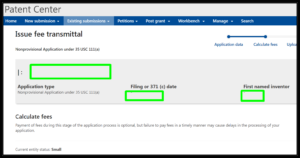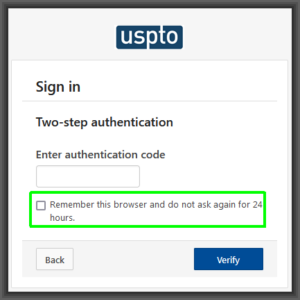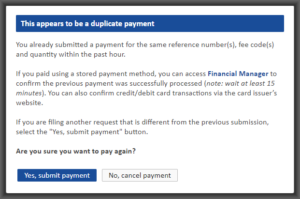This page is mostly for members of the Patentcenter listserv. You should of course join the Patentcenter listserv if you have not done so already. The goal of this page is to make it easy for people to pick trouble tickets and contribute to the communications with the USPTO about Patentcenter. Here is the background.
Right now there are 289 members of the Patentcenter listserv. Seventy-four members signed a letter Dated December 16, 2021 to Drew Hirshfeld, the Acting Director of the USPTO, as you may see here: https://blog.oppedahl.com/?p=7307 . The letter presented six “asks”:
- Direct your Patentcenter developers to identify one or two people from their developer team to subscribe to the Patentcenter listserv to follow the postings. This might sometimes permit those people to pass things along from the listserv to appropriate colleagues on the Patentcenter developer team.
- Direct your developers to formally adopt the Patentcenter listserv trouble ticket page as a “to do” list for trouble ticket action by the developers
- Direct your developers to formally adopt the Patentcenter listserv feature request page as a place for the developers to receive feature requests for Patentcenter.
- Direct your developers to report back to the people of the Patentcenter listserv each time the developers clear a trouble ticket, referencing the listserv trouble ticket number in the report.
- Direct your developers to report back to the people of the Patentcenter listserv each time the developers implement a feature request, referencing the listserv feature request number in the report.
- Direct your developers to cooperate with the people of the Patentcenter listserv by means of some periodic two-way communications by which the progress with trouble tickets and feature requests may be reviewed.
A few days ago, apparently prompted by the letter to Drew Hirshfeld, I received an email from one of the USPTO people in charge of the development of Patentcenter. Of course what I would have hoped is that maybe this person would be calling to say that we will get our six “asks”. That is not what happened during the telephone call.
What did happen is that after some discussion this person agreed to have his people get back to us with USPTO’s view as to its “clearance status” for a selected fraction of the trouble tickets. By this I mean that his people will provide a table with rows and columns, with a row for each of a selected fraction of the tickets. The trouble ticket page presently has 72 tickets number CP1 through CP72. I had hoped to get the USPTO people to agree to provide such a table for all 72 tickets, but we did not get that. Bargaining against myself, I then asked if they would provide such a table for all of the tickets for which the ticket number was a multiple of 3. We did not reach agreement on this. Bargaining further against myself, I then asked if they would provide such a table for all of the tickets for which the ticket number was a multiple of 4. This they agreed to. We will thus hear back, I imagine within a week or two, as to the USPTO’s assessment of the status of 18 of the 72 trouble tickets for Patentcenter. I am sure you will agree with me that this is a very encouraging sign and a reason for guarded optimism as to possible further dialogue about the remaining 54 trouble tickets.
Another development is an agreement on a trial basis to have some small-group get-togethers between selected members of the listserv and selected people from the USPTO who are connected with the Patentcenter developer process. These would be on a weekly basis. The get-togethers would be set up so that there could be shared desktop activity. A chief goal would be to provide opportunities for a listserv member to click and demonstrate or illustrate a particular trouble ticket. A typical goal of this would be to assist the USPTO people for the tickets where the status is that the USPTO had not been able to reproduce the problem. The hope would be that when the listserv person reproduces the problem and the USPTO people see it happening on the screen, this would help the USPTO better appreciate the problem being reported. This might also permit the listserv people to explain verbally how the problem affects users or what might be done to fix the problem. Maybe in some cases the USPTO people would be able to offer comments in response.
If you look at what I just wrote in the previous paragraph, what will jump out at you is that there is an extremely urgent need. We need to figure out which particular tickets are the best candidates for discussion in these upcoming small-group get-togethers. Tickets might fall into several categories.
Tickets that are already fixed. If a particular bug has actually been fixed, and has been fixed correctly, then barring some surprise it seems to me that the ticket would not be a good candidate for discussion in the get-togethers. But we want to be thoughtful about this. It is possible to imagine that as for some particular ticket, the USPTO people might in all good faith think they had fixed the problem but it might actually be that with some particular inputs or application status, the problem still comes up.
Tickets where USPTO people say they are unable to reproduce the problem. This strikes me as an area where the get-togethers could be very very helpful. If a listserv member were able to pick out one or two sets of inputs that reliably demonstrate what goes wrong with some trouble ticket item, and if this can be shown on a shared desktop with the USPTO developers, just imagine how this could make a big difference for all of the people involved.
Tickets where the need is particularly urgent. Some of the Patentcenter bugs strike me as particularly urgent. I can think of several ways that we might think of a particular bug as being urgent.
A bug that presents a big risk of loss of substantive rights, or a trap for the unwary. There are some bugs that I think many of us would feel are urgent simply because the longer they go without being fixed, the more times some applicant will have gotten “burned” by a loss of rights or the need to spend money to fix a problem that should never have arisen. I think of the bugs that have caused me to either lose a filing date or that have caused me to come very close to losing a filing date. I think of the bugs where a perfectly good document like a scanned oath or declaration or a perfectly good scanned IDS got turned into a blank sheet of paper.
A bug where the developers really ought to have fixed it years ago. I am thinking of the “last 40 ack receipts”. Probably there are others in this category.
Tickets where the fix is needed because supposedly the USPTO people are replicating functions of PAIR and EFS-Web. Even now after four years since Patentcenter got launched, with the stated goal that all of the functions of PAIR and EFS-Web would be provided in Patentcenter, there are gaping voids, large and small. For the longest time it was simply impossible to e-file any SFD (subsequently filed document, or follow-on submission) in any 35-series design patent application. Finally they fixed that, sort of. But even now, many seemingly ordinary recurring tasks that you can do in a 29-series design application, such as paying an Issue Fee, are not possible in a 35-series design application. (Well, there is a workaround, but there is no good reason why a workaround should be needed.) Right now if you decide you want to look at recent outgoing correspondence, it works in PAIR but broadly speaking it does not work in Patentcenter. Right now if you want to “search by attorney docket number”, this is easy to do from a starting screen in PAIR, but if you want to try to do it in Patentcenter it is buried in layers of clicking.
Back to “we need your help”.
So what we really need right now is to get a second pair of eyes, and a third pair of eyes, and fourth and fifth, on the trouble ticket list. One reason this is needed is that if indeed the USPTO has fixed some particular bug, we might as well give them credit for it. Shame on them if they never bothered to get back to us to tell us they think they fixed it, but that is a separate matter. The fact is, if they have indeed fixed it, we might as well give them credit for it, and we need to know it is fixed so that we do not accidentally waste the precious and limited small-group meeting time talking about that instead of some ticket that needs fixing.
So each and every one of you practitioners and paralegals who belong to the Patentcenter listserv … please help. Here is what you can do:
Please click “Generate” to pick a trouble ticket number.
Then please go to this page to see which ticket has that number. Then please decide what you think about that trouble ticket. Then please click here to report your findings. Then please come back here to pick another trouble ticket.
If you are not a member of the Patentcenter listserv, please join now. And then please join in this effort to evaluate the trouble tickets, so that we can make best use of this valuable opportunity for direct communication with some of the USPTO people responsible for Patentcenter.
Thank you.



